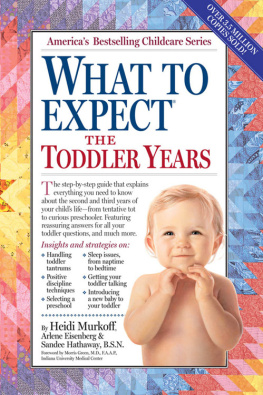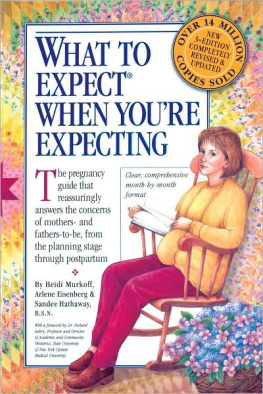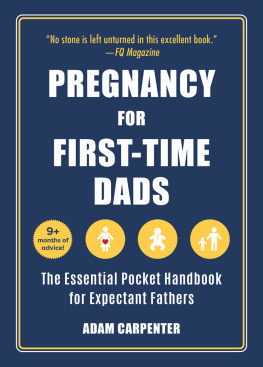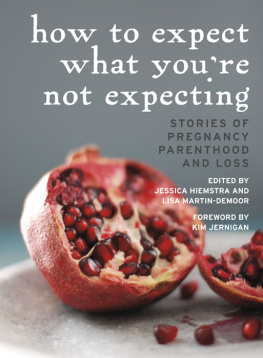ACKNOWLEDGMENTS
A Million Thanks
Much like the eight toddlers weve had the pleasure of parenting, What to Expect the Toddler Years has presented us with countless challenges. And in the four years that it has taken us to research, write, and produce it, weve been lucky enough to work with many wonderful people who have assisted us in facing those challenges. Now, with the book in hand (make that two hands; at 900 plus pages, one hand wont do), wed like to take the opportunity to express our thanks to those who have helped put it there:
 All the readers of our previous books, not only for their input, insights (keep those cards and letters coming!), and their loyalty (so greatly appreciated), but for their patience as they waited (and waited, and waited) for this books arrival.
All the readers of our previous books, not only for their input, insights (keep those cards and letters coming!), and their loyalty (so greatly appreciated), but for their patience as they waited (and waited, and waited) for this books arrival.
 Elizabeth Hathaway, toddler-come-lately, for obligingly posing for countless knock-knee photos, for always doing everything by the book, and for generally being the right age at the right time.
Elizabeth Hathaway, toddler-come-lately, for obligingly posing for countless knock-knee photos, for always doing everything by the book, and for generally being the right age at the right time.
 Dr. Morris Green, our esteemed and distinguished medical advisor, who never flinched (at least visibly) at the endless piles of paper we sent him, who painstakingly crossed our medical ts and dotted our medical is, who brought not just scientific knowledge, but great sensitivity to the task, and who worked at laser speed no matter how busy he was on other projects.
Dr. Morris Green, our esteemed and distinguished medical advisor, who never flinched (at least visibly) at the endless piles of paper we sent him, who painstakingly crossed our medical ts and dotted our medical is, who brought not just scientific knowledge, but great sensitivity to the task, and who worked at laser speed no matter how busy he was on other projects.
 Suzanne Rafer, our intrepid editor and good friend (shed have to be), who waded through the sea of manuscript with her usual grace, style, sense of humor, and more flags than the United Nations will ever see.
Suzanne Rafer, our intrepid editor and good friend (shed have to be), who waded through the sea of manuscript with her usual grace, style, sense of humor, and more flags than the United Nations will ever see.
 The entire Workman team and extended family, but especially Lisa Hollander and Janet Vicario for their artistic expertise; Judit Bodnar for perceptive copy-editing, and Joan L. Giurdanella and Rob Sternitzky for attentive proofreading; David Schiller for copy that lets readers tell our books by their covers; and Peter Workman for his wisdom, understanding, and patience.
The entire Workman team and extended family, but especially Lisa Hollander and Janet Vicario for their artistic expertise; Judit Bodnar for perceptive copy-editing, and Joan L. Giurdanella and Rob Sternitzky for attentive proofreading; David Schiller for copy that lets readers tell our books by their covers; and Peter Workman for his wisdom, understanding, and patience.
 Marika Hahn for adorning the book with so many adorable toddlers.
Marika Hahn for adorning the book with so many adorable toddlers.
 Dr. Mark Widome for his invaluable support and assistance, particularly on matters of toddler safety and first aid. And the many others whove lent their expertise, including Carole Marcus, M.D., J. Rutt Reigart, M.D., Kathy Leonard, M.D., Al Mooney, M.D., Shelly Bazes, C.N.P., W. K. Frankenburg, M.D., Beverly Bresnick, Cate DAmboise, Sara Jacobs, Ann Wimpheimer, Alan Friedman, Sue Kellerman, Wendy Sax, Barbara Braun, Susanna Morgenthau, Mimi Gelb, Eve Coulson, Aliza Cotton, Michael Rand, and the moms and dads whove plied us with questions at our parenting groups and seminars.
Dr. Mark Widome for his invaluable support and assistance, particularly on matters of toddler safety and first aid. And the many others whove lent their expertise, including Carole Marcus, M.D., J. Rutt Reigart, M.D., Kathy Leonard, M.D., Al Mooney, M.D., Shelly Bazes, C.N.P., W. K. Frankenburg, M.D., Beverly Bresnick, Cate DAmboise, Sara Jacobs, Ann Wimpheimer, Alan Friedman, Sue Kellerman, Wendy Sax, Barbara Braun, Susanna Morgenthau, Mimi Gelb, Eve Coulson, Aliza Cotton, Michael Rand, and the moms and dads whove plied us with questions at our parenting groups and seminars.
 The terrific staff at the American Academy of Pediatrics, including Michael Copeland, Carolyn Kolbaba, Leslee Williams, and former staff member Michelle Weber, for helping to keep our books accurate and up-to-date.
The terrific staff at the American Academy of Pediatrics, including Michael Copeland, Carolyn Kolbaba, Leslee Williams, and former staff member Michelle Weber, for helping to keep our books accurate and up-to-date.
 The editors of Contemporary Pediatrics for invaluable assistance whenever called upon; Juliann Goldman of C.S.P.I.; and N.A.P.N.A.P.
The editors of Contemporary Pediatrics for invaluable assistance whenever called upon; Juliann Goldman of C.S.P.I.; and N.A.P.N.A.P.
 Tameka Hall and Niurka Zameta, crackerjack assistants, who kept up with filing mountains of articles from journals and newsletters, checked phone numbers, and otherwise kept our office going.
Tameka Hall and Niurka Zameta, crackerjack assistants, who kept up with filing mountains of articles from journals and newsletters, checked phone numbers, and otherwise kept our office going.
 Abby and Norman Murkoff and, as always, Mildred and Harry Scharaga for unflagging support.
Abby and Norman Murkoff and, as always, Mildred and Harry Scharaga for unflagging support.
READY REFERENCE
What Can I Do Now?
It doesnt have to be a rainy day for you to run out of activities that keep your toddler busyand happy. (How many hours can you spend at the park or in the backyard, after alleven under the bluest skies?) The following are a sampling of toddler-tested, time-honored activities thatll prove just as satisfying on a sunny afternoon as they will on a rainy one. Make your selections according to your toddlers age and stage of development.
Crayons, redux. What to do with that growing pile of crayon nibs and squibs that your toddler wont touch? Recycle them into multicolor crayon balls. Together peel the paper wraps off the crayons and combine pieces of several different colors together in a plastic sandwich bag. Seal the bag with tape or tie it with a rubber band and leave it in the sun or in a baking dish placed in a just-warm oven until the crayons have softened. Mold the molten mass into balls and refrigerate until firmand get ready for some colorful coloring.
Be lyrical. Compose new lyrics to a favorite song. Pick a song, any song, and take turns singing it with made-up words, the sillier the better. Or try to communicate only in song for a few minutes on the way to the supermarket or while youre making dinnercreating a sort of parent-child operetta.
Follow the leader. Take turns being the leader who decides when to crawl, when to run, when to clap hands, when to hop, when to jump. Alternatively, one of you can shout out action directions (Stretch! Touch your toes! Walk very fast!) while the other performs them. Or play copy cat, and take turns making funny faces that the other can imitate. A simplified, low-pressure (no losers or winners) form of Simon Says not only can be fun for toddlers, it can improve their coordination and their ability to follow directions.
Play ball. Learning to catch isnt easy for toddlers. Make it easier by using a ball thats big enough to eyeball but not so big that it can knock your toddler over. Have your toddler stand with arms out and palms up. Standing close (less than a foot away to start with), toss the ball gently into your toddlers hands and instruct him or her to hug it so it wont fall out. Acknowledge unsuccessful attempts with Good try. Once catching at that distance has been mastered, move a little farther away. Also try bouncing the ball to your toddler at an easy-to-grab height.
Get gooey. Mix some cornstarch with water to a gruel-like consistencythen dig in with your hands. Show your toddler how the mixture feels when you squeeze it in your hand and when you let it ooze between your fingers. This activity can be used to pass time when youre in the kitchen cooking or as tension-relaxation therapy.
String your toddler along. Once your childs old enough to be trusted with smaller objects, provide a variety of safe stringables (spools, large pasta tubes, cereal circles, big buttons, large wooden beads) to thread onto a piece of thin plastic tubing (because its relatively rigid, the tubing is easier for small hands to manipulate and safer than ordinary string) or a shoelace.
Bowl em over. Line up a few empty plastic soda bottles, unopened rolls of paper towels, or stuffed animals (vary the pins), and show your toddler how to roll a large rubber ball to knock them over. You can even try knocking over a block pile if the ball is heavy enough.
Make maracas. Fill several small, slim-necked, easy-to-grasp plastic bottles with rice, macaroni, and/or dried beans. Secure the bottle cap with masking tape and let your toddler shake, shake, shake to lively Latin tunes. (Allow your toddler to use this instrument only under supervisiongiven time, most tots can remove the tape and unscrew the cap.)







 All the readers of our previous books, not only for their input, insights (keep those cards and letters coming!), and their loyalty (so greatly appreciated), but for their patience as they waited (and waited, and waited) for this books arrival.
All the readers of our previous books, not only for their input, insights (keep those cards and letters coming!), and their loyalty (so greatly appreciated), but for their patience as they waited (and waited, and waited) for this books arrival.